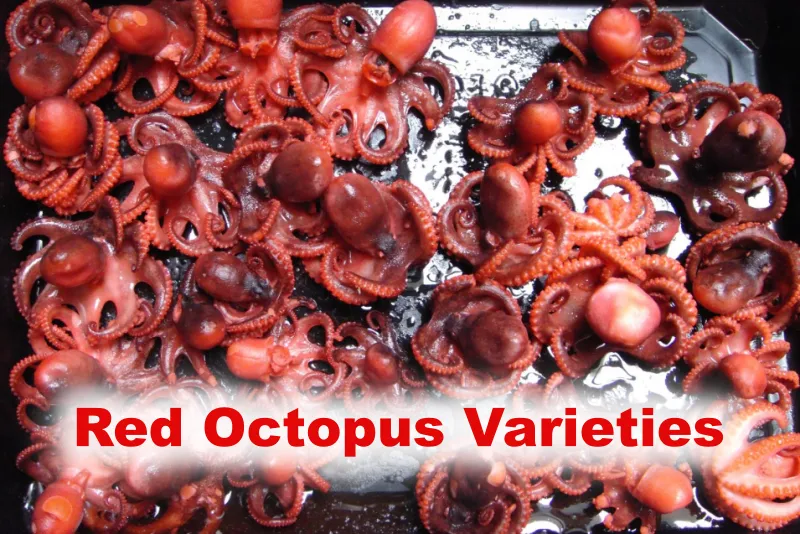Have you ever seen a red octopus? My cousin recently showed me a red octopus picture that he saw during his trip. The color of that cute flapjack octopus fascinated me to the core. So I learned about all the other different red octopi found on Earth.
Here is a list of the 20 red octopus varieties discovered on Earth. So let’s get started on this colorful octopus adventure.
20 Red Octopus Varieties on Earth
1. Capricorn Octopus
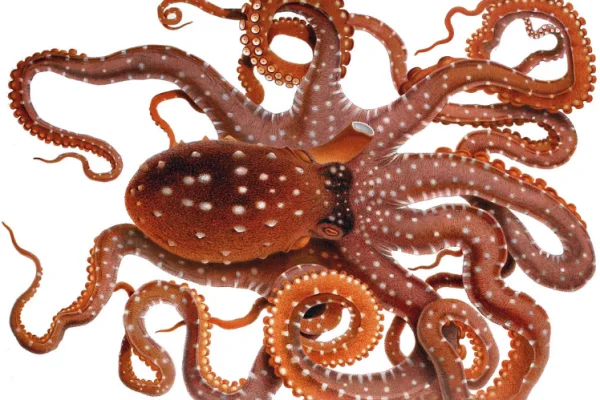
| Scientific name | Callistoctopus alphaeus |
| Identification | Reddish color, white papillae on its body |
| Geographical Location | Australia |
This nocturnal species of octopus, Callistoctopus alphaeus, is commonly found in the Western Pacific Ocean, especially in Australia. The name Capricorn Octopus comes from the shape its arms take around its body.
It has a reddish-orange body with white papillae and long arms. This octopus is small and can attain a mantle length of 43 cm. They are also known as night octopuses because they come out of their caves in the dark waters to forage for their food.
2. Giant Pacific Octopus
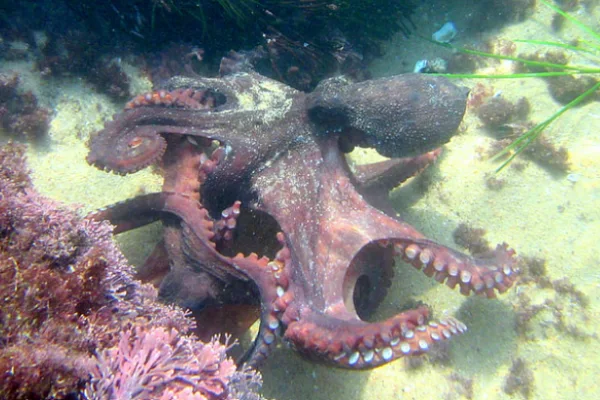
| Scientific name | Enteroctopus dofleini |
| Identification | Reddish color, white suckers, have longitudinal folds and paddle-like papillae on the body |
| Geographical Location | Coastal North Pacific, Mexico, United States, Canada, Russia, Eastern China, Japan, and the Korean Peninsula |
Do you know what the biggest and longest-living octopus in the world is? Well, scientifically, we call it Enteroctopus dofleini, commonly known as the Giant Pacific Octopus.
This interesting animal lives in the cold and oxygen-rich regions of the North Pacific Ocean. Let’s talk about their appearance. These red octopuses are very large, with an arm span of 4.3 m.
Their large suckers are white and have the ability to lift up to 16 kg. Apart from their appealing appearance, they are very intelligent, and research has proven that they can recognize different humans and interact with them in different ways.
3. Common blanket Octopus
| Scientific name | Tremoctopus violaceus |
| Identification | has long, transparent webs that connect some of its arms |
| Geographical Location | Europe, North America, South America, Africa, Asia |
Do you know what’s one of the coolest animals in the ocean? It is Tremoctopus violaceus, also known as the Common Blanket Octopus or Violet Blanket Octopus.
It is a large octopus found worldwide in the epipelagic zone of warm seas. They have transparent webs that impart a deep maroon color. Dramatic sexual dimorphism is seen in this octopus. Females are 2m in length, whereas males are 2.4 m.
The males and young females rip off the tentacles of the Portuguese man of war and use them to fight or catch food. Males have a hectocotylus, which has a sperm-filled pouch between the arms that they use for mating.
4. Southern keeled Octopus
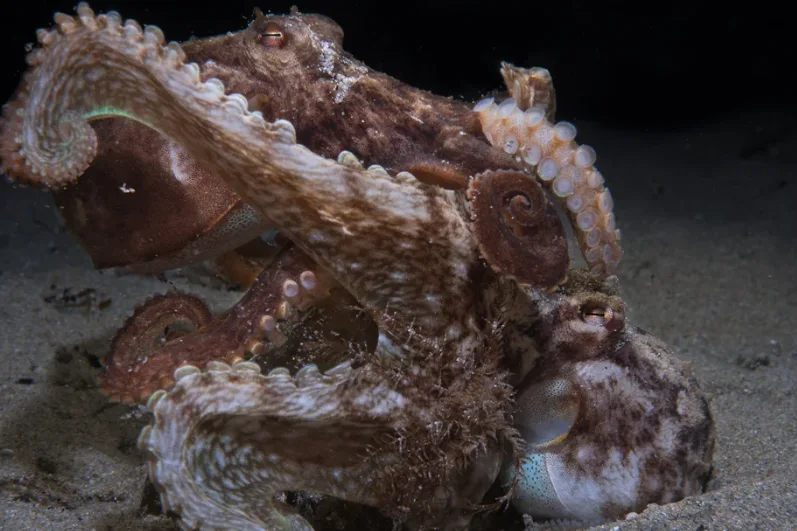
| Scientific name | Octopus berrima |
| Identification | Cream to light brown with a skin keel around the mantle edge |
| Geographical Location | Australia |
Have you heard of the Southern-keeled Octopus (Octopus berrima)? This animal is indigenous to the temperate waters of southern Australia and New South Wales.
These animals are cream to light brown in color, with a distinctive skin keel around the edge of their mantle. They are often mistaken for Octopus australis in appearance. They are known for their impressive camouflage abilities.
5. Caribbean reef Octopus
| Scientific name | Octopus briareus |
| Identification | Bright green and blue with red-brown specks across their bodies |
| Geographical Location | North and South America |
You can find these colorful octopuses in the Nearctic region, the Neotropical region (Central and South America), oceanic islands, and the Pacific Ocean.
As their name indicates, these Caribbean reef octopuses are found in the coral reef vicinity. They are introverts and don’t like to socialize much except for mating.
As we are more concerned about appearance, they are typically bright green and blue with red-brown specks across their bodies, and they can grow up to 120 mm.
These carnivorous and nocturnal animals primarily feed on crabs, shrimp, lobsters, polychaetes, and a variety of fish.
6. East Pacific Red Octopus
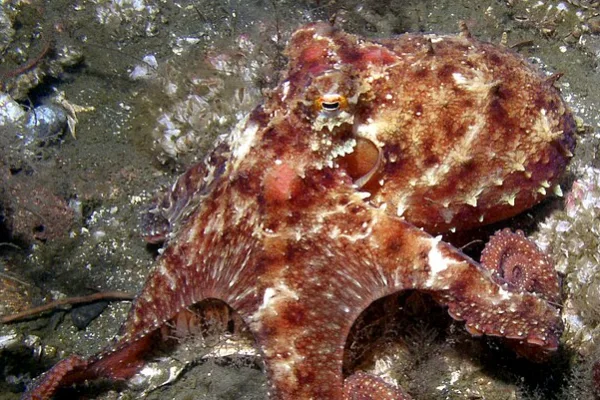
| Scientific name | Octopus rubescens |
| Identification | Presence of three eyelash-like papillae |
| Geographical Location | North America |
Not only their name but also their appearance they look like mini forms of Enteroctopus dofleini. Like other octopuses, they can also change their color from a deep brick red to brown to white.
They can be differentiated from E. dofleini by the presence of three eyelash-like papillae which are present in these octopuses. Individual personalities are also seen in this species. this species is easily found in North America.
7. Star sucker Pygmy Octopus
| Scientific name | Octopus wolfi |
| Identification | Pattern of “papillate fringes” around the edge of the suckers |
| Geographical Location | Western Pacific Ocean |
Octopus wolfi is also known as the star-sucker pygmy octopus because of its small size (about 2.5 cm) and unusual pattern of papillate fringes around the suckers’ edges.
These octopuses can be found all over the western Pacific Ocean. It can make ink fool predators and can even disguise itself or act like something else to get away.
8. Flapjack Octopus
| Scientific name | Opisthoteuthis californiana |
| Identification | Umbrella Shape pink colored body |
| Geographical Location | North America |
You’ve probably seen that flipping octopus toy. Opisthoteuthis californiana inspired the design of that toy. The flapjack octopus is a little, squishy octopus with the ability to flatten itself like a pancake or an umbrella.
They are pinkish to red in color and can attain a length of up to 20 cm. You can find these octopuses in North America. The Flapjack Octopus feeds on small fish, plankton, crustaceans, and worms.
9. Coconut Octopus
| Scientific name | Amphioctopus marginatus |
| Identification | It has a dark color pattern with vein-like lines and a yellow siphon |
| Geographical Location | Southern Japan, Australia, New Guinea, and South Africa. |
As you can see in the above picture, these octopuses are really beautiful, with a dark red color pattern with vein-like lines and a yellow siphon.
These octopuses are known for their tool-making abilities and use coconut shells as helmets or to camouflage themselves.
They are commonly known as the coconut octopus because of their bipedal motion, which appears to mimic a floating coconut.
The mating ritual of these octopuses is also very interesting. They use the ”the faster the better” method approach.
10. Atlantic White-spotted Octopus

| Scientific name | Callistoctopus macropus |
| Identification | They are red in color with white blotches on the body and paired white spots on the arms. |
| Geographical Location | Europe, Asia, Africa |
What a magnificent creature this Callistoctopus macropus is! It is the largest octopus, with an average mantle length of 20 cm. This red octopus has white blotches on its red body and white spots on its arms.
You can find the Mediterranean Sea, the temperate and tropical Atlantic Ocean, the Caribbean Sea, and the Pacific and Indian Oceans. It is a nocturnal hunter that feeds on small fish and invertebrates that hide among corals.
11. Wunderpus Octopus
| Scientific name | Wunderpus photogenicus |
| Identification | Pale orange to red in color with distinctive white bands |
| Geographical Location | Indo-Malayan Archipelago, Vanuatu to Papua New Guinea, Indonesia and Malaysia, north to the Philippines |
Do you want to know about the most marvelous animal in the sea? Meet Wunderpus photogenicus. They are known for their ability to mimic other sea animals, such as lionfish, sea snakes, and flatfish, by changing their shape, color, and behavior.
They are red in color with a unique pattern of white spots and bands. One can find these octopuses from the Indo-Malayan archipelago to the Philippines.
Interspecific aggressive foraging behavior is a characteristic feature of the Wunderpus octopus.
12. Mosaic Octopus
| Scientific name | Abdopus abaculus |
| Identification | Small spikes are present all over the body |
| Geographical Location | Western Central Pacific |
Mosaic Octopus is the common name of Abdopus abaculus. This octopus got its name due to its dark purple-to-red coloration with cream-to-light purple spots.
They are commonly found in the western central Pacific at depths of 0 to 5 meters. This diurnal animal mostly feeds on small crustaceans, mollusks, and worms.
13. Poison Ocellate Octopus
| Scientific name | Amphioctopus mototi |
| Identification | Orange-cream-brown in color with black papillae over each eye |
| Geographical Location | From Okinawa, Japan to Australia and throughout the South Pacific |
The poison ocellate octopus or the mototi octopus are some of the common names of Amphioctopus mototi. Their body color ranges from orange to reddish-brown, with black papillae over each eye.
You can find them from Okinawa, Japan, to Australia, inhabiting coral reefs, coral rubble, and sand habitats. They use their paralytic saliva to paralyze their prey and primarily feed on shellfish and hermit crabs.
14. Sandbird Octopus
| Scientific name | Amphioctopus aegina |
| Identification | They have large, light white colored round patches, and dark reticulations separate their dorsal surface. |
| Geographical Location | from Mozambique to the Red Sea and Japan. |
Amphioctopus aegina is the next octopus on our list. They can be found in depths ranging from 30 to 120 meters, from Mozambique to the Red Sea and Japan.
This medium-sized octopus has remarkable red color patterns of circular patches separated by dark reticulations on its dorsal side.
It mostly feeds on crustaceans like crabs and shrimp, as well as clams, which it splits open with its powerful beak.
15. Curled Octopus
| Scientific name | Eledone cirrhosa |
| Identification | Two horn-like filaments are present above both eyes |
| Geographical Location | Europe (from the southern-west coast of Norway down to Greece) |
You must have known this octopus by its different names, such as horned octopus, lesser octopus, or northern octopus. As their name indicates, their color ranges from yellowish to red, with a white underside and two horn-like filaments present above both eyes.
By reaching a length of 12 to 40 cm, females are slightly larger than males. These large crustaceans feeding on octopuses have tightly curled arms.
16. Gloomy Octopus
| Scientific name | Octopus tetricus |
| Identification | have a gray to brown coloration with rufous arm faces and white eyes |
| Geographical Location | New South Wales, eastern Australian coastline |
This Eastern Australian native species is known for its distinctive appearance. It has a gray to reddish brown color with rufous arm faces that taper towards the tip. These moderate-sized octopi are found in the subtropical regions of Eastern Australia and Northern New Zealand.
Cannibalism is also seen in the females of these species, who usually gulp the males after mating. These nocturnal animals primarily feed on crustaceans and mollusks by using their sharp beaks.
17. East Asian Common Octopus
| Scientific name | Octopus sinensis |
| Identification | they have mantles without rigid skeletons and have horizontal pupils |
| Geographical Location | South Korea, China, and Japan |
Meet this close relative of Octopus vulgaris, Octopus sinensis. This type of red octopus is commonly found in the coastal waters of South Korea, China, and Japan. The color of their body ranges from brown to reddish brown with white spots.
They have the ability to change their skin color and texture depending on their mood and surrounding environment. One of their arms has erectile tissue on its tip and is specially adapted for reproduction.
18. Robsonella fontaniana
| Scientific name | Robsonella fontaniana |
| Identification | have a dorsal white spot anterior to the head |
| Geographical Location | Central-south coast of Chile and southern Argentina |
The next animal we have on our list is Robsonella fontaniana. This cold-water inhabitant species is commonly found in South America, from Peru to Cabo de Hornos in Chile (Pacific Ocean) and Puerto Madryn in Argentina (Atlantic Ocean). They have white spots on the anterior side of their redhead.
This bright red octopus shows sexual dimorphism. Males of this species tend to be larger than females. This species is considered a potential species for aquaculture diversification.
19. Hairy Octopus
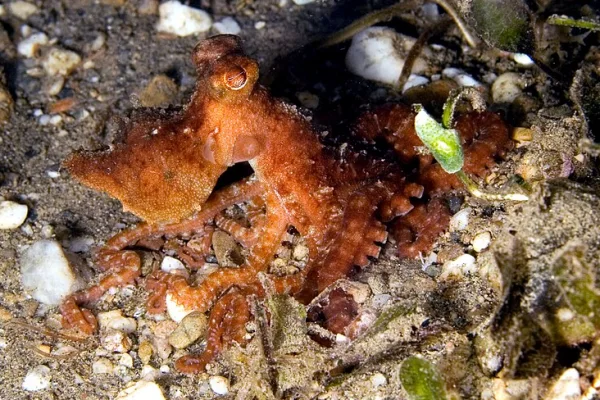
| Scientific name | Octopus sp. |
| Identification | numerous papillae are present on their whole body |
| Geographical Location | Indonesia |
This newly discovered octopus species made its way onto this list. As its name suggests, this octopus has a hairy appearance and is often mistaken for a tuft of algae floating on the sea floor.
They are small, with an average length of 2 to 5 cm, and their body color ranges from white to brown and ruby red. There is not much information available about this animal. It was recently reported in the Lembeh Strait off North Sulawesi, Indonesia.
20. Starry Night Octopus
| Scientific name | Callistoctopus luteus |
| Identification | have small white fixed papillae are present throughout their body |
| Geographical Location | Western Pacific region |
This beautiful octopus is commonly called the starry night octopus because of its reddish-brown body with small white papillae that resemble the stars in the night sky. This relatively large octopus of length 70 cm is commonly found in the Western Pacific Ocean.
It is a nocturnal hunter that feeds on fish, invertebrates, and other octopuses. Like most octopuses, males and females usually die shortly after mating.
Conclusion
I hope you found all this information about the types of red octopuses interesting. These octopus species are so well adapted that they better survive and thrive in the environment through camouflage, bioluminescence, venom, and intelligence.
They have more than just a beautiful appearance; they are also very smart and resourceful. There is a lot to know about these animals. We will be back soon with another new topic.
Also Read:

Being a zoology student I’m always been fascinated toward animals especially insects. I love to do research and learn about different animals. As a writer I want to share my thoughts about nature through my articles. Apart from this you can find me exploring the new places and voice notes.
